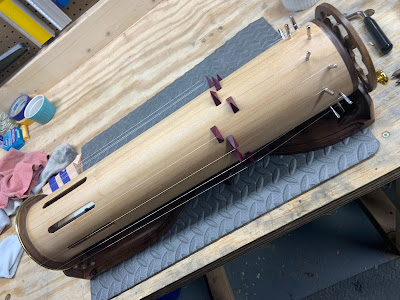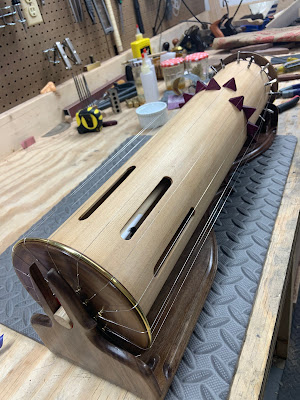Did someone else already invent this?
Posted: Tue Jan 23, 2024 10:42 pm
Over the past about three years, I've been working on an instrument of my own design; I call it a "rotola." I've attached pix below.
The original design (what you see in the pix) had 16 strings; I've made some modifications since that I'll discuss below. The sounding body of the instrument is comprised of eight soundboard panels of sitka spruce steam bent and edge-glued into a cylinder. The nut (left) end has a solid walnut internal disc to which the soundboards are glued (not visible from the outside), capped by a external walnut disc -- also of eight sections (like a pizza) -- circumferenced with a brass rod that serves as a nut and into which the strings' end pins are anchored (small brass nails visible in the left side view). The tuning pin (right) end has a pinblock made of two layers of 3/4" Baltic birch plywood cut into eighths (again, pizza-like) to which the other end of the soundboards attach (also not visible from outside) and which is capped by a solid walnut decorative plate. Through the center of the entire cylinder runs a shaft of ash to serve as an axle and to bear most of the weight of the string tension. This axle rests in a walnut stand that serves only as a support and bearing surface within which the entire instrument may freely turn (see view from above). Outside this stand on the right is a solid walnut crank allowing the player to rotate the instrument (visible with a brass knob in the right side view). Strings are steel zither strings, 0.012", relatively lightly tensioned, while the bridges are purpleheart and can be moved to allow individual strings to be tuned to different pitches (compare to a koto or gayageum). Finally, the instrument is played by a highly curved steam bent ash bow with untensioned horsehair (see bowing pic) that wraps around the body to play up to half the strings at once.
In terms of the performance design of the instrument, it was conceived as a drone, especially as a monochord, to be performed by a single player. This prototype is quite a bit smaller than my initial vision -- think 'cello range as what I ultimately aim for -- with a lowest pitch of F above middle C, and with the steel zither strings its sound is very bright. However, as the strings resonate with each other -- both the bowed and the freely resonating -- it creates a rich (and loud) sound, as monochords are known for. With the moveable bridges, it can be tuned to play chords as well. My intention for the instrument was as a meditation aid, which I have found it to be delightful for. I am still working on creating a recording of it to share, but I have noticed that the impact of its rich resonance is very difficult to capture.
I'm posting here because I want to hear about others' experiences with similar instruments. Although this was an original idea, I know that there is very little that is actually new in the universe and would be unsurprised -- but delighted -- to learn of others on this forum who may have built like designs. Indeed, right around the time I finished the rotola (last November), I found a video on Facebook of a Brazilian band that had created a large, upright version requiring two players, performing with it several years ago https://www.facebook.com/watch/?v=975781312507473.
Once the rotola was complete and I could spend time experimenting with it, I discovered that half of the strings had wolfs of varying severity (violin family instrument performers will be familiar with this term describing notes that are especially non-resonant and make a kind of choking sound). After messing about with it, I determined that the issue was not limited to particular tunings or pitches, as it would be with a violin-family instrument, but particular strings, specifically, every alternating one. Of the eight with wolfs, two were still playable, so I removed the six with bad wolfs and the now ten-string instrument is even more resonant. I plan to experiment further with this and to address the issue in the next iteration.
I have posts on my personal blog detailing (for novices) my design and construction over the years; I can share links here if that is helpful, but I'll wait for requests, given that this post is already pretty long.
Please share with me your responses, thoughts, ideas, insights, etc., especially if you have built a similar thing!
view from above:
left hand view:
right hand view:
bowing:
The original design (what you see in the pix) had 16 strings; I've made some modifications since that I'll discuss below. The sounding body of the instrument is comprised of eight soundboard panels of sitka spruce steam bent and edge-glued into a cylinder. The nut (left) end has a solid walnut internal disc to which the soundboards are glued (not visible from the outside), capped by a external walnut disc -- also of eight sections (like a pizza) -- circumferenced with a brass rod that serves as a nut and into which the strings' end pins are anchored (small brass nails visible in the left side view). The tuning pin (right) end has a pinblock made of two layers of 3/4" Baltic birch plywood cut into eighths (again, pizza-like) to which the other end of the soundboards attach (also not visible from outside) and which is capped by a solid walnut decorative plate. Through the center of the entire cylinder runs a shaft of ash to serve as an axle and to bear most of the weight of the string tension. This axle rests in a walnut stand that serves only as a support and bearing surface within which the entire instrument may freely turn (see view from above). Outside this stand on the right is a solid walnut crank allowing the player to rotate the instrument (visible with a brass knob in the right side view). Strings are steel zither strings, 0.012", relatively lightly tensioned, while the bridges are purpleheart and can be moved to allow individual strings to be tuned to different pitches (compare to a koto or gayageum). Finally, the instrument is played by a highly curved steam bent ash bow with untensioned horsehair (see bowing pic) that wraps around the body to play up to half the strings at once.
In terms of the performance design of the instrument, it was conceived as a drone, especially as a monochord, to be performed by a single player. This prototype is quite a bit smaller than my initial vision -- think 'cello range as what I ultimately aim for -- with a lowest pitch of F above middle C, and with the steel zither strings its sound is very bright. However, as the strings resonate with each other -- both the bowed and the freely resonating -- it creates a rich (and loud) sound, as monochords are known for. With the moveable bridges, it can be tuned to play chords as well. My intention for the instrument was as a meditation aid, which I have found it to be delightful for. I am still working on creating a recording of it to share, but I have noticed that the impact of its rich resonance is very difficult to capture.
I'm posting here because I want to hear about others' experiences with similar instruments. Although this was an original idea, I know that there is very little that is actually new in the universe and would be unsurprised -- but delighted -- to learn of others on this forum who may have built like designs. Indeed, right around the time I finished the rotola (last November), I found a video on Facebook of a Brazilian band that had created a large, upright version requiring two players, performing with it several years ago https://www.facebook.com/watch/?v=975781312507473.
Once the rotola was complete and I could spend time experimenting with it, I discovered that half of the strings had wolfs of varying severity (violin family instrument performers will be familiar with this term describing notes that are especially non-resonant and make a kind of choking sound). After messing about with it, I determined that the issue was not limited to particular tunings or pitches, as it would be with a violin-family instrument, but particular strings, specifically, every alternating one. Of the eight with wolfs, two were still playable, so I removed the six with bad wolfs and the now ten-string instrument is even more resonant. I plan to experiment further with this and to address the issue in the next iteration.
I have posts on my personal blog detailing (for novices) my design and construction over the years; I can share links here if that is helpful, but I'll wait for requests, given that this post is already pretty long.
Please share with me your responses, thoughts, ideas, insights, etc., especially if you have built a similar thing!
view from above:

left hand view:

right hand view:

bowing:
